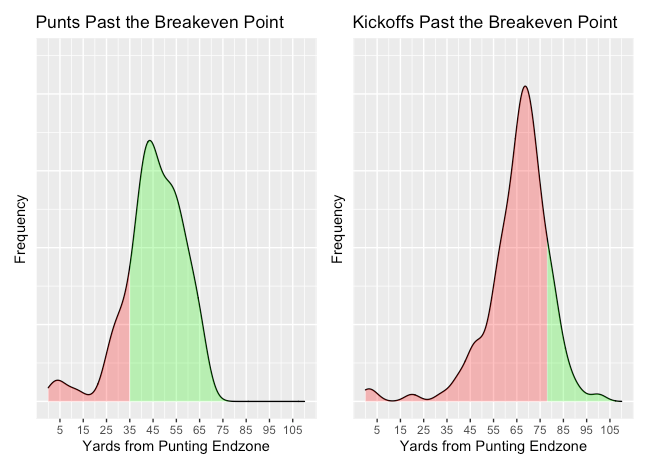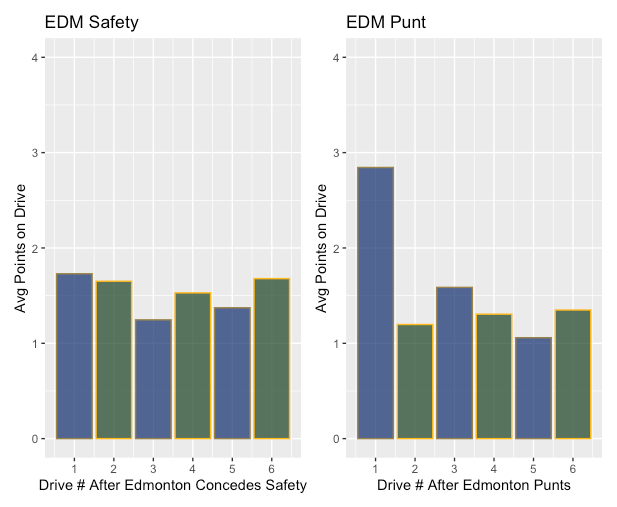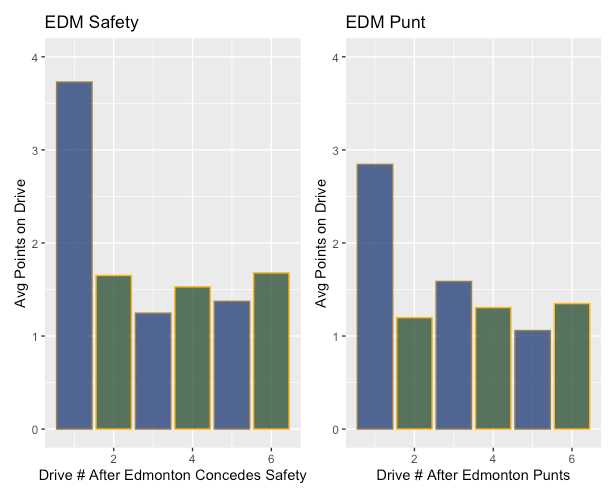The Definitive Safety Guide
After three very controversial calls to concede a safety this week, I decided to do a deep dive to figure out once and for all if CFL teams should be taking safeties, or if they should punt it no matter what. The three decisions in question are two from Edmonton (who is also doing some galaxy brain stuff starting Cornelius) and from Montreal. Hilariously, perhaps Winnipeg's only mistakes of the game came when choosing what to do after the safeties. On all three, they decided to scrimmage from their own 35, instead of making Edmonton kickoff, which averages a starting point of a teams' own 44.
Montreal's safety was somewhat more mind boggling, moving the game from a 1 point affair to 3. Let's take a look.
Montreal's safety was somewhat more mind boggling, moving the game from a 1 point affair to 3. Let's take a look.
Yards
Firstly, I'd just like to look at the trade-off coaches are making by conceding a safety versus punting from their own end zone. I pulled all punting safeties, as well as all kickoffs from the 25 yard line. Say Edmonton is playing Winnipeg. An Edmonton punt puts the ball at Edmonton's own 46 yard line, whereas an Edmonton safety & then kickoff puts the ball at Edmonton's opponent's 44 yard line, on average.
So, by opting to concede a safety, Edmonton is essentially giving up 2 points for ~20 yards.
Would you give up 2 points for 20 yards?
So, by opting to concede a safety, Edmonton is essentially giving up 2 points for ~20 yards.
Would you give up 2 points for 20 yards?

Expected Points
If it is not immediately apparent, no, you should not give up 20 yards in exchange for 2 points. A way to see this is through expected points. Expected points assigns a value for each yardline, allowing comparison between yardlines based on scoring probabilities from those yardlines. For example, a 1st and 10 at a team's own 25 yardline is worth ~0.175 expected points, while a 1st and 10 at the opponent's 1 yardline is worth 6.7 expected points.
With this, we can compare a 1st and 10 from the average starting field position after a punt, and a 1st and 10 from the average starting field position after a safety & kickoff.
From the perspective of the punting team:
1) 1st and 10, 46 yards from the endzone == -3 expected points
2) 1st and 10, 66 yards from the endzone == -1.71 expected points - 2 real points
Taking a safety gives the opponent 2 points. Then you kickoff and give them another 1.71, totalling -3.71 expected points for the conceding team. Punting to the opponent gives them an average of 3 epts, totalling -3 expected points for the conceding team. Based on historic averages, Punting is clearly the correct decision.
With this, we can compare a 1st and 10 from the average starting field position after a punt, and a 1st and 10 from the average starting field position after a safety & kickoff.
From the perspective of the punting team:
1) 1st and 10, 46 yards from the endzone == -3 expected points
2) 1st and 10, 66 yards from the endzone == -1.71 expected points - 2 real points
Taking a safety gives the opponent 2 points. Then you kickoff and give them another 1.71, totalling -3.71 expected points for the conceding team. Punting to the opponent gives them an average of 3 epts, totalling -3 expected points for the conceding team. Based on historic averages, Punting is clearly the correct decision.
Epts Continued
The question then, is where is the breakeven point? What if you had a horrible punter, or there was an injury?
Thankfully, this is a fairly trivial exercise. All we are looking for is the yardline where the opposing team hits 3.71 expected points. Based on my expected points model, this happens at the 35 yard line. So, if you are confident your punter & coverage team can get a minimum net 34 yard punt, you should go ahead and punt it away. If not, you should either be looking for a new punter, curse the wind, or concede the safety.
This breakeven point does not change depending on the yardline the punting team is on. In actuality, it is far worse to concede a safety from the 8 yard line, as you still only need to get it to the 35 to break-even. This would be a net 28 yard punt.
Alternatively, if you have a big kicker, the breakeven point to consider conceding a safety & kicking would be getting the kickoff to the opponent's 32 yardline. This would be a massive kickoff.
Let's look at how often teams hit those breakeven points:
Thankfully, this is a fairly trivial exercise. All we are looking for is the yardline where the opposing team hits 3.71 expected points. Based on my expected points model, this happens at the 35 yard line. So, if you are confident your punter & coverage team can get a minimum net 34 yard punt, you should go ahead and punt it away. If not, you should either be looking for a new punter, curse the wind, or concede the safety.
This breakeven point does not change depending on the yardline the punting team is on. In actuality, it is far worse to concede a safety from the 8 yard line, as you still only need to get it to the 35 to break-even. This would be a net 28 yard punt.
Alternatively, if you have a big kicker, the breakeven point to consider conceding a safety & kicking would be getting the kickoff to the opponent's 32 yardline. This would be a massive kickoff.
Let's look at how often teams hit those breakeven points:

I don't know about you, but I think I'll take my chances with a punt.
More
As I was considering this problem, I began to go in circles deciding if coaches were trying to trade short-term pain for long-term gain or vice-versa. Giving up two points is painful, but the theory is that you only give up two, and then your next possessions should be more fruitful. I'd like to look at how scoring rates change depending on how many drives from
a) a kickoff from the 25 yard line (aka kickoff after a safety is conceded) and
b) a punt from the 10 yard line or closer.
Let's start with how I believe coaches see it:
a) a kickoff from the 25 yard line (aka kickoff after a safety is conceded) and
b) a punt from the 10 yard line or closer.
Let's start with how I believe coaches see it:

Let's say, for no reason, that Edmonton is debating taking a safety when playing Winnipeg.
Winnipeg's average points on their drives stay pretty steady after a safety is conceded. On the other hand, a punt spikes the average points on Winnipeg's first and second drives. It is my hypothesis that coaches want to "reduce risk" and choose the first, where scoring opportunities are back to pretty much even, and in their head, they avoid the uncertainty of giving up 0, 3, or 7 points for giving up a guaranteed 2 points.
Now, lets look at what the actual chart should look like:
Winnipeg's average points on their drives stay pretty steady after a safety is conceded. On the other hand, a punt spikes the average points on Winnipeg's first and second drives. It is my hypothesis that coaches want to "reduce risk" and choose the first, where scoring opportunities are back to pretty much even, and in their head, they avoid the uncertainty of giving up 0, 3, or 7 points for giving up a guaranteed 2 points.
Now, lets look at what the actual chart should look like:

This chart more accurately represents what a team is giving up when they choose a safety over a punt. Again, the prognosis is not good. Giving up a safety is essentially giving up a drive worth 3.7 points versus punting and giving up a drive worth under 3 points.
It is also cool to see expected points "working." The expected point values calculated above match these charts very well, with a punt being worth -3 epts to Edmonton (basically what it is at, after factoring in the 2nd Winnipeg drive), as well as a safety being worth -3.7 epts to Edmonton.
It is also cool to see expected points "working." The expected point values calculated above match these charts very well, with a punt being worth -3 epts to Edmonton (basically what it is at, after factoring in the 2nd Winnipeg drive), as well as a safety being worth -3.7 epts to Edmonton.
Montreal
Unfortunately I'd have to do more work to calculate why in the world Montreal conceded a safety to go down 3. My in-game win probability model implicitly assigns a chance of a safety being conceded, and thus, only saw the decision as -3% WP, but assigned a good chunk of negative WP when the previous plays' sack was awarded and it looked more and more likely that Montreal was going to concede a safety.
For reference, Chris Clement had the decision at -14% WP, which makes a lot more sense.
For reference, Chris Clement had the decision at -14% WP, which makes a lot more sense.

Just don't take safeties. Live a little, trust your defence, and you will come out on top.
